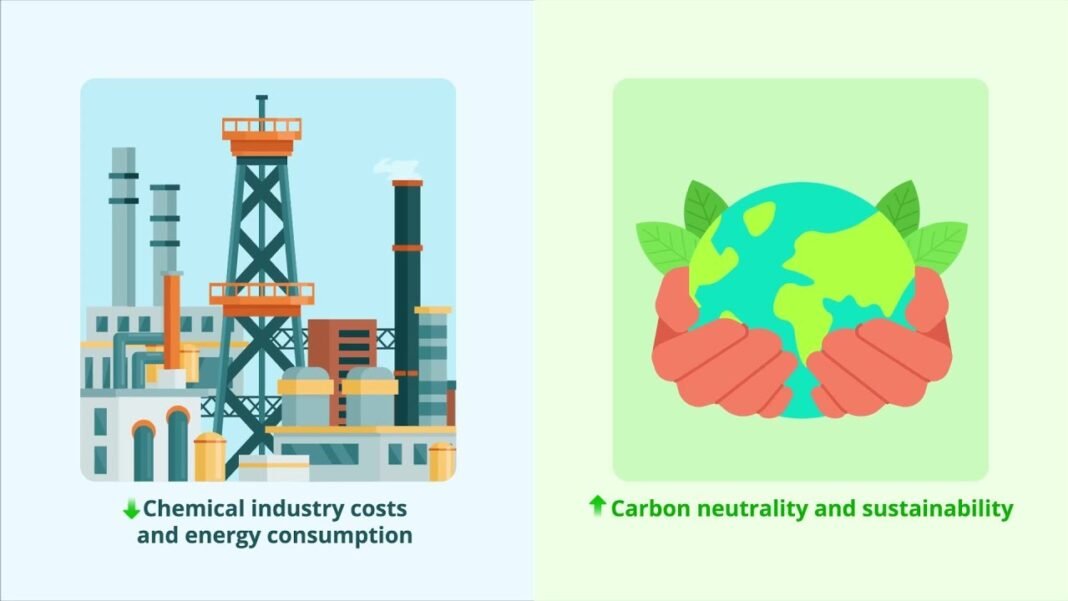Nagoya, 30 March 2024 (TDI): Researchers achieve high selectivity and permeability in a pervaporation setup which could replace energy-intensive distillation processes in chemical industries.
Membrane-based separation of organic liquids is a rapidly emerging field that could make chemical industries more energy efficient. In a recent study, researchers from Japan developed a new type of organosilica membrane. derived from a silylated ionic liquid.
Several experiments in a pervaporation setup demonstrated the highly promising properties of this membrane when separating organic liquids. This versatile technology will contribute to more sustainable pharmaceutical and hydrocarbon industries and pave the way to carbon neutrality.
In many chemical-related industries, such as pharmaceuticals, oil refineries, and food and beverage factories, separating organic liquid mixtures is an essential step. A staple method to achieve this is distillation, which involves heating a mixture to a specific temperature so that only one of its components vaporizes.
Though widely used, distillation fails to separate organic liquid mixtures in which both components have the same boiling point. Moreover, it’s an energy- and resource-intensive process, which has motivated researchers to look for more sustainable alternatives.
Over the past few years, membrane-based separation techniques have been steadily gaining traction, since they can be more energy efficient and offer better selectivity than conventional methods.
While many types of separation membranes exist, membranes produced from ionic liquids (ILs) are rarely used for separating organic liquid mixtures, mainly due to issues with stability and a poor understanding of their properties.
To address these limitations, a research team from Japan set out to investigate the performance and mechanisms of a new type of IL-based organosilica membrane for organic liquid separation.
The team included Associate Professor Yuichiro Hirota from Nagoya Institute of Technology, Dr. Ayumi Ikeda from the National Institute of Advanced Industrial Science and Technology, and Associate Professor Sadao Araki from Kansai University.
Their study was made available online on December 29th, 2023, and published in Volume 694 of the Journal of Membrane Science on February 1st, 2024.
The separation technique the researchers used is called pervaporation (PV). “The PV method deals with the partial vaporization of a liquid mixture through a membrane whose downstream side is under vacuum, which helps achieve a higher permeability,” explains Dr. Hirota. Based on previous results using IL-based membranes to separate organic vapors, the team expected PV to be suitable for separating mixtures of organic liquids.
First, the researchers produced an imidazolium-type IL by replacing the chloride ions in 1-methyl-3-(1-triethoxysilylpropyl)imidazolium chloride (SipmimCl) with bis(trifluoromethylsulfonyl)imide ions (Tf2N−) to obtain SipmimTf2N.
After washing SipmimTf2N with water and allowing the viscous product to decant, the team obtained a chemically stabilized polymer via drying, called polySipmimTf2N, which contains silsesquioxanes.
Finally, to create the membranes, the researchers coated the outer surface of hollow nanoporous aluminum oxide tubes with a solution of methanol and polySipmimTf2N.
Several experiments were then conducted to analyze the properties and performance of these membranes in the PV method.
First, through unary PV tests (that is, involving a single organic compound rather than a mixture), the researchers measured the permeability of different alcohols, aromatic hydrocarbons, and alkanes. They also explored how the permeability values were related to each compound’s Hansen solubility parameters (HSPs) and those of the membrane itself.
Afterwards, they conducted binary PV tests, in which they separated toluene, methanol, and 1-hexanol from n-hexane. As Dr. Hirota explains, each of these tests addressed a particular challenge in organic liquid separation: “The toluene/n-hexane mixture was an aromatic/alkane mixture with differences in volatility and molecular size.
Also Read: COMSTECH and Karolinska Institute Advancing Research on Combatting Infectious Diseases
On the other hand, the methanol/n-hexane mixture was an azeotropic mixture, and thus both components had equal boiling points. Finally, the 1-hexanol/n-hexane mixture was selected because it would be difficult to separate using molecular sieving membranes.”
Interestingly, the membranes performed exceptionally well when separating toluene from n-hexane, achieving a high permeance ratio of 11. Moreover, the membranes were highly selective when separating 1-hexanol from n-hexane.
As the data from the HSP-based analyses confirmed, the separation performance of the proposed membranes was closely related to the affinity between the target compound and the membrane itself. This implies that the ions forming the ionic liquid could be replaced depending on the target organic liquid mixture to achieve efficient separation.
Taken together, these results of this study highlight the potential of IL-based chemically stabilized membranes for the affinity-based separation of organic liquids.
Since PV could one day replace energy-intensive distillation processes, these findings will contribute towards more sustainable chemical industries. With any luck, this should pave the way to carbon neutrality and ultimately mitigate global warming.
The Diplomatic Insight is a digital and print magazine focusing on diplomacy, defense, and development publishing since 2009.



